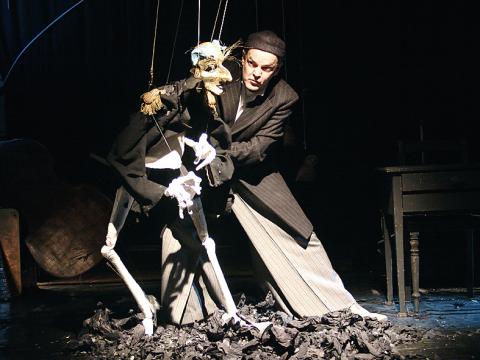For its debut performance in Taiwan, German puppet group Figuren Theater Tubingen will perform Salto.Lamento, or the “nocturnal side of affairs.”
The award-winning production was inspired by the medieval iconography of the Dance of Death, a funeral rite practiced when Europe lost much of its population to the Black Death during the 14th century.
Acclaimed German puppeteer Frank Soehnle, who cofounded the group with Karin Ersching in 1991, says that puppetry is a good vehicle for presenting skeletons dancing with people, which also reminds him of the relationship between himself and his puppet.

Photo Courtesy of Figuren Theater Tubingen
“In puppetry, you don’t look only at the puppets. You also look at the puppeteer and what is happening in this [puppeteer-puppet] relationship. It’s like a dance. It’s like giving life or taking death from one to the other,” Soehnle told the Taipei Times.
Without one uttered word, the piece is an exquisite danse macabre between the sole puppeteer and his array of puppets. They depict various characters, from a flirtatious half-woman, half-horse puppet to a monastic figure and a naughty sheep-goat creation. The performance is composed of vignettes choreographed to live music by Johannes Frisch and Stefan Mertin, who have been working with Soehnle since their first collaboration 20 years ago.
Like an alchemist, Soehnle instills life into the inert figures with a superb artistry. He exerts a light twist of the strings or a slight maneuver of a stick and the puppets swing into action as if they were completely autonomous. The interplay between life and death finds its most intense manifestation when a life-size masked faun manages to sever its strings and gain freedom. But the creature soon suffers the consequences of its actions and falls lifeless to the floor.
Inhabited by skeletal figures and chimeric creatures, the world of Salto.Lamento is as nightmarish and somber as it is playful and comical. Some puppets display a zany sense of humor, like a fussy devilish figure that demands live accompaniment from the musician duo when he sweeps and cleans.
Frisch and Mertin, who play live on stage, interact and communicate with the puppets with their instruments.
“The music is never the same,” the 48-year-old puppeteer said. “It is breathing with the whole performance.”
After five sold-out performances in Taipei last week, the group moves on to Tainan tomorrow.

In the March 9 edition of the Taipei Times a piece by Ninon Godefroy ran with the headine “The quiet, gentle rhythm of Taiwan.” It started with the line “Taiwan is a small, humble place. There is no Eiffel Tower, no pyramids — no singular attraction that draws the world’s attention.” I laughed out loud at that. This was out of no disrespect for the author or the piece, which made some interesting analogies and good points about how both Din Tai Fung’s and Taiwan Semiconductor Manufacturing Co’s (TSMC, 台積電) meticulous attention to detail and quality are not quite up to

April 21 to April 27 Hsieh Er’s (謝娥) political fortunes were rising fast after she got out of jail and joined the Chinese Nationalist Party (KMT) in December 1945. Not only did she hold key positions in various committees, she was elected the only woman on the Taipei City Council and headed to Nanjing in 1946 as the sole Taiwanese female representative to the National Constituent Assembly. With the support of first lady Soong May-ling (宋美齡), she started the Taipei Women’s Association and Taiwan Provincial Women’s Association, where she

It is one of the more remarkable facts of Taiwan history that it was never occupied or claimed by any of the numerous kingdoms of southern China — Han or otherwise — that lay just across the water from it. None of their brilliant ministers ever discovered that Taiwan was a “core interest” of the state whose annexation was “inevitable.” As Paul Kua notes in an excellent monograph laying out how the Portuguese gave Taiwan the name “Formosa,” the first Europeans to express an interest in occupying Taiwan were the Spanish. Tonio Andrade in his seminal work, How Taiwan Became Chinese,

Mongolian influencer Anudari Daarya looks effortlessly glamorous and carefree in her social media posts — but the classically trained pianist’s road to acceptance as a transgender artist has been anything but easy. She is one of a growing number of Mongolian LGBTQ youth challenging stereotypes and fighting for acceptance through media representation in the socially conservative country. LGBTQ Mongolians often hide their identities from their employers and colleagues for fear of discrimination, with a survey by the non-profit LGBT Centre Mongolia showing that only 20 percent of people felt comfortable coming out at work. Daarya, 25, said she has faced discrimination since she